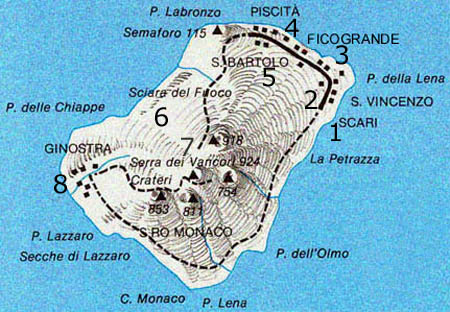 Stromboli Island (STRONGYLE) Area 12,6 km sq. Inhabitants 550
Stromboli Island (STRONGYLE) Area 12,6 km sq. Inhabitants 550

CLIMBING STROMBOLI
For further information (click on the link hereunder):
The flora of Stromboli includes an
important endemism of the Eolian, the Cytisus Aeolicus, the
family tree of Pulses, who once had to be thick along the
slopes of the island. Today this species survives in places
Schicciole, and its protection has been launched with a
project ( "Eolife 99") cofinanced by EU, which is
interesting also another endemismo, Chenopodiacea Bassia
Saxicola, living on Strombolicchio.
History
The most distant and
most of eastern Eolian is Stromboli about 22
miles from Lipari. The island is a volcano that
emerges from the sea and the part emerged is in
persistent activity at least 2000 years, it was
mainly formed during two cycles of activity. An
ancient cycle, consisting of solid material
eruptions and lava flows that formed across the
eastern part of the island; most recent cycle, which
consists of lava flows, which was the whole western
half of the island. The current activity is
considered part of the recent cycle. The crater area
is formed by three cones, whose volcanic activity is
predominantly explosive.
Stromboli is the only volcano in Europe and one of
the few in the world in eruptive activity
permanently. For this reason the island has
been described, from classical age the "lighthouse
of Tirreno". Stromboli was inhabited up to the
Bronze Age. In 1975, was discovered a necropolis
Greek with tombs of the end of the fourth and the
first decades of the third century. BC
Economic activity was
based on agriculture. The decline of the population
started in 1930, when a strong eruption and a
terrifying tsunami convinced many islanders to
emigrate. In the'50s began to develop tourist
activity and many of the houses in Aeolian style,
abandoned at the time the eruption of 1930, once
restored have become a destination for holidays.
General
Information
It is the northernmost
of the islands and has a population of about 550
inhabitants. The island, north of which rises
steeply to the rock Strombolicchio, is a volcanic
edifice, which touches 926 m, and presents various
eruptive vents, always active, with spectacular
eruptions lapilli and incandescent materials, which
precipitate long the steep wall called Sciara del
Fuoco. The volcanic apparatus is a so-called
strato-vulcano or mixed volcano, which is derived
from rocks lava flows alternate with layers of
pyroclastic materials. It goes under the sea for
thousand meters: were in fact submarine the first
eruptive events, dating to the cenozoica era
or tertiary. High and dirupate are the coasts, with
small beaches. The population living in Ginostra
centers and Stromboli, and the traditional economic
activities are fishing, viticulture and the
collection of capers, and, in increasing measure,
tourism. Archaeological excavations have brought to
light ruins of a Greek necropolis.
Excursions over
land Starting from the quayside Scari we can go
to see the streets and alleys of St. Bartolo,
the saint patron of the island. In front of the pier
of Ficogrande, about a mile from the coast, stands
majestic (the shape of a medieval castle) the islet
of Strombolicchio. As it is the rest of a small cone
of an eruption side.
Trekking
Naturalistic interest is climbing crater. Three
hours of travel to reach high altitudes, allowing to
attend the explosions from areas nearby. It is
appropriate to make the trip with guides.
Tours by sea
Starting from Scari, arriving at the surface of
water in front of Punta Labronzo you can admire the
Sciara del Fuoco "picturesque explosion of lapilli
and glowing lava flows. Continuing to reach the
small village of Ginostra, untouched paradise, with
the green of the Mediterranean scrub and the deep
blue sea.
Sciara del Fuoco
Wall rock that sinks in deeper depths, depths
inaccessible to divers, pointing towards the
pit of the Tyrrhenian (over three thousand
meters deep).
The Dorsale of
Sciara This is a massive ridge with two peaks:
the first is at 35 meters, the second at 20. Reached
35 meters, opens a precipice, which is lost in a
black abyss. The fund's rocks discovered a large
quantity of stars Pentagon.
The Secca of
Scirocco This is a massive mountain surrounded
by a number of large boulders rich in fish and with
a spectacular morphologies all its sides are covered
with red coral and gorgonians.
TO VISIT:
Volcanological Observatory,
Church of St. Vincent
EXCURSIONS:
At Crater (obligation to guide authorized). Ginostra, and
solitary picturesque hamlet of Stromboli, reaching for lovers of trekking in
four and a half hours of travel
NOT MISS:
Tour of the island. Stopping at: Old Forge
(ancient sciara); Punta dell'Olmo; Punta Lena (uninhabited
village); Punta Lazzaro or Pertuso (Ginostra); Sciara del
fuoco; Piscità and Ficogrande, elegant bay before
Strombolicchio (islet high 43 m. surmounted by the
lighthouse)

LEGENDA: 1-Scari
2-San Vincenzo
3-Ficogrande
4-Piscità
5-San Bartolo
6-Sciara del Fuoco
7-Vancori (sopra i crateri del vulcano)
8-Ginostra